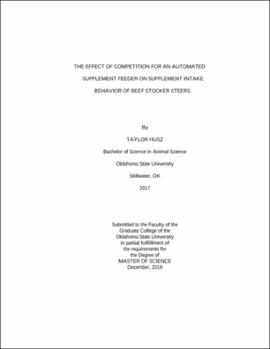| dc.contributor.advisor | Reuter, Ryan | |
| dc.contributor.author | Husz, Taylor | |
| dc.date.accessioned | 2020-06-29T17:39:43Z | |
| dc.date.available | 2020-06-29T17:39:43Z | |
| dc.date.issued | 2019-12 | |
| dc.identifier.uri | https://hdl.handle.net/11244/324924 | |
| dc.description.abstract | The objective of this research was to determine the effect of competition for a feeding space at an automated supplement feeder on supplement intake behavior. A 2-yr study was conducted; each yr, 128 mixed-breed beef steers (initial BW = 245 ± 27.5 kg) were randomly assigned to 8 paddocks. One paddock each yr (n = 16 steers) was selected to have continuous access to the feeder for the duration of the 16-wk trial; this paddock was designated the "tester" paddock. The automated feeder had 4 feeding stations that dispensed supplement to individual animals. Steers were limited to 0.50 kg supplement/d. Additional paddocks were commingled with the tester paddock, weekly to increase competition for the feeder. Mean weekly supplement intake and GPS location were recorded for steers in the tester paddock. Additionally, pedometer data were collected in yr 2. Weekly mean supplement intake and time spent near the feeder were regressed on actual feeder stocking density with yr as a random variable. Competition for a feeding station numerically reduced (P = 0.01) supplement intake by 4 g/d per steer of additional competition. Steers spent 4.4% of the time within 15-m of the feeder regardless of competition (P = 0.54). As competition increased, steers took more steps (P < 0.01). The objective of the second study was to determine the effects of supplementation level and type on forage intake of steers grazing a high-quality native range. On d 0, steers (n=16, initial BW = 193.7 kg ± 14.3 kg) were randomly assigned to one of 5 dietary treatments, fed once daily in individual stalls for 28-d. Treatments were control (no supplement, n=4), or supplemented with either CSM or DRC, each at either 0.45 kg or 1.81 kg as-fed/d (n=3 for each combination). Some steers had orts, therefore actual mean supplement intake was used in analysis. Results were analyzed with regression, with animal as the experimental unit. Forage intake did not differ by supplement type when offered at 0.45 kg/d yet with increasing supplement forage intake declined for CSM but increased for DRC (P = 0.01). | |
| dc.format | application/pdf | |
| dc.language | en_US | |
| dc.rights | Copyright is held by the author who has granted the Oklahoma State University Library the non-exclusive right to share this material in its institutional repository. Contact Digital Library Services at lib-dls@okstate.edu or 405-744-9161 for the permission policy on the use, reproduction or distribution of this material. | |
| dc.title | Effect of competition for an automated supplement feeder on supplement intake behavior of beef stocker steers | |
| dc.contributor.committeeMember | Wilson, Blake | |
| dc.contributor.committeeMember | Lalman, David | |
| dc.contributor.committeeMember | Beck, Paul | |
| osu.filename | Husz_okstate_0664M_16522.pdf | |
| osu.accesstype | Open Access | |
| dc.type.genre | Thesis | |
| dc.type.material | Text | |
| dc.subject.keywords | beef cattle | |
| dc.subject.keywords | behavior | |
| dc.subject.keywords | competition | |
| dc.subject.keywords | precision technology | |
| dc.subject.keywords | stocker steers | |
| dc.subject.keywords | supplementation | |
| thesis.degree.discipline | Animal Science | |
| thesis.degree.grantor | Oklahoma State University | |
